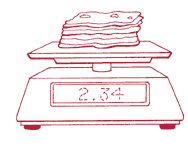|
|
Kids Math Lesson - Weighing In
What you'll need:A grocery scale or your scale at homeWhat to do:1) Help your child examine the scale in the grocery store or the one you have at home. Explain that pounds are divided into smaller parts called ounces and 16 ounces equal a pound.2) Gather the produce you are purchasing, and estimate the weight of each item before weighing it. If you need 1 pound of grapes, ask your child to place the first bunch of grapes on the weighing scale, and then estimate how many more or fewer grapes are needed to make exactly 1 pound. 3) Let your child hold an item in each hand and guess which item weighs more. Then use the scale to check. 4) Ask questions to encourage thinking about measurement and estimation. You might want to ask your child: How much do you think 6 apples will weigh? More than a pound, less than a pound, or equal to a pound? How much do the apples really weigh? Do they weigh more or less than you estimated? Will 6 potatoes weigh more or less than the apples? How much do potatoes cost per pound? If they cost 10 cents per pound, what is the total cost? 5) Try weighing items using the metric system. How many grams does an apple weigh? How many kilograms does a sack of potatoes weigh? How does a kilogram compare to a pound? 6) Let your child experiment with the store scale by weighing different products. Parent Tip:There are many opportunities to increase estimation and measurement skills by weighing objects in the produce section of the grocery store.
| |||
| |
| | |